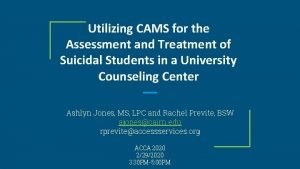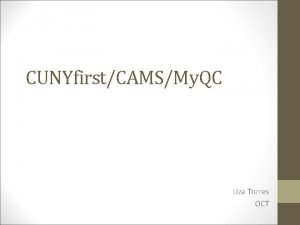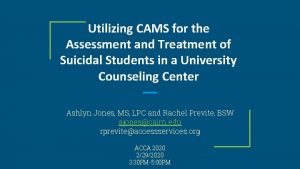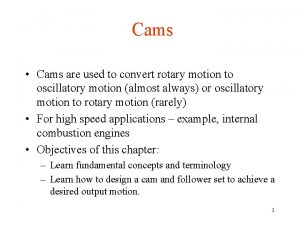Utilizing CAMS for the Assessment and Treatment of





































- Slides: 37

Utilizing CAMS for the Assessment and Treatment of Suicidal Students in a University Counseling Center Ashlyn Jones, MS, LPC and Rachel Previte, BSW ajones@cairn. edu rprevite@accessservices. org ACCA 2020 2/29/2020 3: 30 PM-5: 00 PM

Session Description Accurately and effectively identifying and treating suicidal risk is a primary concern for university counseling center directors, staff and administration. The Collaborative Assessment and Management of Suicidality (CAMS) offers a framework in which to assess and treat suicidal ideation and behavior. The CAMS model first offers a philosophy of care as well as an empirically supported intervention and suicide specific approach. The goal of the session is to introduce the model, the basics of utilizing CAMS and how it is used in assessment and treatment of suicidal clients in a university counseling center.

Objectives · Participants will evaluate the CAMS model and its effectiveness within a university counseling center. · Participants will articulate an understanding of the philosophy of care that CAMS outlines and how it serves suicidal clients. · Participants will conceptualize two opportunities to integrate the model or the philosophy of care into their counseling centers.

Hearing from the participants Name/University role/suicide assessment used What cultural changes around suicide awareness/prevention have you noticed in the larger culture? Your university culture?

Prevention campaigns Who is at risk? Seize the Awkward: https: //www. youtube. com/watch? v=g. B 95 Cc 9 dgn. I Is Your Safety On? : https: //vimeo. com/175761640 Means Matter - Harvard University

Suicide Statistics ● Suicide is the 10 th leading cause of death in the US for all ages. (CDC) ● There is one death by suicide in the US every 12. 3 minutes. (CDC) ● An estimated quarter million people each year become suicide survivors (AAS). ● There is one suicide for every estimated 25 suicide attempts. (CDC) ● There is one suicide for every estimated 4 suicide attempts in the elderly. (CDC) ● The number of suicides are twice that of homicides ● Suicide is the 2 nd leading cause of death for 15 to 24 year old Americans. (CDC) ● Suicide is the 4 th leading cause of death for adults ages 18 -65. (CDC)

Oasis Counseling Center in Cairn University Total enrollment: ~1, 300 Active clients in Oasis: ~150 Staff: 9 interns, 4 staff members As of early February, ~30 CAMS assessments have been done, 3 hospitalizations, 11 have used CAMS as follow up care and treatment

Suicide Assessment What suicide assessments do you use? Why? What do you like about them? How are they effective for your site? Where do you feel the “gaps” when it comes to suicide assessment?

ASIST - Applied Suicide Intervention Skills Training (Living Works) ● https: //www. livingworks. net/asist QPR - Question Persuade Refer (QPR Institute) ● https: //qprinstitute. com/ Calm - Counseling on Access to Lethal Means (SPRC) ● https: //www. sprc. org/resources-programs/calm-counseling-access-lethal-means Columbia ● http: //cssrs. columbia. edu/the-columbia-scale-c-ssrs/about-the-scale/



The Aim of the CAMS approach a. Making suicide a proper focus of treatment (rather than the mental disorder) b. Work to keep a suicidal person out of an inpatient setting c. The superiority of various forms of stabilization planning to no-harm contracting d. The importance of empathy for suicidality and collaboration to successful treatment e. The role of the patient as a key partner in therapy through the treatment of patient defined problems that make the patient suicidal

Philosophy of Care according to CAMS approach https: //www. youtube. com/watch? v=Ra. Bhg. Jag. Ytw First 4: 30 minutes; pg 4 What stood out from Dr. Jobes description of his approach?

Rationale of CAMS a. The use of CAMS is recommended for best care practices, it’s holistic form and empirically supported approach focuses on the suicidal thoughts in treatment (Jobes, 2012; Poston & Hanson, 2010). b. It is important from a liability standpoint to have documented thoroughly the assessment of suicidal thoughts, the likelihood of suicidality and the approach that you take with a suicidal client.

Client Conditions for Treatment a. come to treatment, commit to come for three months b. reduce/remove the access to lethal means c. use coping cards (intervention specific) 5 things they could do if they get impulsive, out of control, depressed, desperate or suicidal d. create interpersonal support

CAMS Model -it’s a suicide focused theoretical framework “Non denominational” designed to be flexible and adaptable -guided by the Suicide Status Form (SSF) Assessment, treatment planning, stabilization plan, tracking of ongoing risk, case notes and clinical outcomes








Questions?







CAMS Stabilization Plan Ways to reduce access to lethal means Things I can do to cope differently when I am in a suicide crisis (consider crisis card) Life or death emergency contact number People I call for help or to decrease my isolation Attending treatment as scheduled (potential barriers/solutions)

Possible Interventions to Use with a CAMS treatment plan DBT Chain Analysis is basically a detailed account of the events, thoughts, emotions, and behaviors of a person that lead to the problematic behavior or event. Often this chain is done visually to help the client see all the connections between the initial vulnerability and final consequences. Mindfulness Techniques Grounding Techniques

Coping Cards Developing a set of coping strategies written on the backs of cards that the client can pull out, handle in a tangible way and practice when they are in vulnerable states. On one side will be the contact details of the counselor which can only be used as a last resort when all the suggestions on the other side of the card has been tried. On the other side of the card can be list a number of things that the client can do in the event that they become desperate. This is so that the client becomes thick skinned and resistant to the pressures and learn to cope differently. There will also be the name of someone in their life who is committed to walking alongside them and whom they can contact before contacting the counselor

Hope Kit The purpose of the Hope Kit is to give the client concrete reasons to stay alive in a tangible and easily accessible format. Items can be anything from photographs, letters, keepsakes that have sentimental value for client. The client encouraged to be as creative as possible so that kit containers items that are deeply meaningful to them and are a powerful reminder of the connection they have to life whenever feeling suicidal. (e. g. , a scrapbook, a collage, or a painting) Basically, the hope box is a therapeutic technique that is used in cognitive behavioral therapy that aims to help the client “fight the tunnel vision and distorted thinking that can occur with suicidal thoughts – to give yourself reminders of hope even when you feel none. ” Also available in an app format: Virtual Hope Box with coping cards, activity planners, coping mechanisms, favorite photos, favorite quotes, distraction options etc.

Integrating CAMS in a University Counseling Center -Practicalities The time it takes, what it assess’, follow up care -Competent training of interns in suicide assessment and treatment, uses in supervision -Ability to conceptualize the suicidal person’s experience -language used increases this ability -Client is the expert, most important participant in their treatment

Other Resources Online training and resources- https: //cams-care. com/ Managing Suicidal Risk: A Collaborative Approach By: David Jobes Articles on the psychometric properties of CAMS/SSF Jobes, 2012 Poston & Hanson, 2010

References Berk, M. S. , Henriques, G. R. , Warman, D. B. , Brown, G. K. & Beck, A. T. (2004). A cognitive therapy intervention for suicide attempters: An overview of the treatment and case examples. Cognitive and Behavioral Practice, 11(3), 265 -277 "Clinical Training in Suicide Prevention. " Aaron T. Beck Psychopathology Research Center. N. p. , n. d. Web. Ellis, T. E. , Daza, P. , & Allen, J. G. (2012). Collaborative assessment and management of suicidality at Menninger (CAMS-M): An inpatient adaptation and implementation. Bulletin of The Menninger Clinic, 76(2), 147 -171. Geller, S. M. (2017). Deepening the experience of therapeutic presence: Grounding, immersion, expansion, and compassion exercises. In, A practical guide to cultivating therapeutic presence (pp. 172 -196). Washington, DC, US: American Psychological Association. doi: 10. 1037/0000025 -011 Hall, E. , Hall, C. , & Stradling, P. (2006). Guided imagery. Retrieved from http: //0 ebookcentral. proquest. com. library. cairn. edu/lib/cairn/detail. action? doc. ID=334406 Managing Suicidal Risk in Clinical Practice [Video file]. (2011). PESI Inc. Retrieved June 7, 2017, from Academic Video Online: Premium. Stanley, B & Brown, G. (2012). Safety and planning intervention: A brief intervention to mitigate suicide risk. Cognitive and Behavioral Practice, 19(1), 256 -264
 Cams suicide assessment
Cams suicide assessment Graduation gremlins
Graduation gremlins Funky-cams
Funky-cams Cams a
Cams a Dirty router live
Dirty router live How to use hellosign
How to use hellosign Cuny first qc
Cuny first qc Listening strategies
Listening strategies Angle tackling
Angle tackling Assessment and treatment alternatives
Assessment and treatment alternatives Kontinuitetshantering i praktiken
Kontinuitetshantering i praktiken Typiska novell drag
Typiska novell drag Tack för att ni lyssnade bild
Tack för att ni lyssnade bild Vad står k.r.å.k.a.n för
Vad står k.r.å.k.a.n för Shingelfrisyren
Shingelfrisyren En lathund för arbete med kontinuitetshantering
En lathund för arbete med kontinuitetshantering Underlag för särskild löneskatt på pensionskostnader
Underlag för särskild löneskatt på pensionskostnader Personlig tidbok för yrkesförare
Personlig tidbok för yrkesförare Anatomi organ reproduksi
Anatomi organ reproduksi Densitet vatten
Densitet vatten Datorkunskap för nybörjare
Datorkunskap för nybörjare Boverket ka
Boverket ka Att skriva en debattartikel
Att skriva en debattartikel För och nackdelar med firo
För och nackdelar med firo Nyckelkompetenser för livslångt lärande
Nyckelkompetenser för livslångt lärande Påbyggnader för flakfordon
Påbyggnader för flakfordon Formel för lufttryck
Formel för lufttryck Svenskt ramverk för digital samverkan
Svenskt ramverk för digital samverkan Lyckans minut erik lindorm analys
Lyckans minut erik lindorm analys Presentera för publik crossboss
Presentera för publik crossboss Jiddisch
Jiddisch Kanaans land
Kanaans land Treserva lathund
Treserva lathund Fimbrietratt
Fimbrietratt Bästa kameran för astrofoto
Bästa kameran för astrofoto Centrum för kunskap och säkerhet
Centrum för kunskap och säkerhet Verifikationsplan
Verifikationsplan Bra mat för unga idrottare
Bra mat för unga idrottare




























































